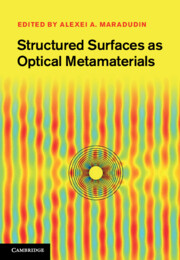Book contents
- Frontmatter
- Contents
- List of contributors
- Preface
- 1 Physics of extraordinary transmission through subwavelength hole arrays
- 2 Resonant optical properties of nanoporous metal surfaces
- 3 Optical wave interaction with two-dimensional arrays of plasmonic nanoparticles
- 4 Chirality and anisotropy of planar metamaterials
- 5 Novel optical devices using negative refraction of light by periodically corrugated surfaces
- 6 Transformation of optical fields by structured surfaces
- 7 Surface electromagnetic waves on structured perfectly conducting surfaces
- 8 Negative refraction using plasmonic structures that are atomically flat
- 9 Anomalous transmission in waveguides with correlated disorder in surface profiles
- 10 Cloaking
- 11 Linear and nonlinear phenomena with resonating surface polariton waves and their applications
- Index
- Plate section
- References
3 - Optical wave interaction with two-dimensional arrays of plasmonic nanoparticles
Published online by Cambridge University Press: 01 June 2011
- Frontmatter
- Contents
- List of contributors
- Preface
- 1 Physics of extraordinary transmission through subwavelength hole arrays
- 2 Resonant optical properties of nanoporous metal surfaces
- 3 Optical wave interaction with two-dimensional arrays of plasmonic nanoparticles
- 4 Chirality and anisotropy of planar metamaterials
- 5 Novel optical devices using negative refraction of light by periodically corrugated surfaces
- 6 Transformation of optical fields by structured surfaces
- 7 Surface electromagnetic waves on structured perfectly conducting surfaces
- 8 Negative refraction using plasmonic structures that are atomically flat
- 9 Anomalous transmission in waveguides with correlated disorder in surface profiles
- 10 Cloaking
- 11 Linear and nonlinear phenomena with resonating surface polariton waves and their applications
- Index
- Plate section
- References
Summary
Introduction
Nanotechnology has seen enormous progress in recent years, and various techniques are now available for the realization of ordered periodic arrays of particles with nanoscale dimensions. Electron-beam [1] and interference lithography [2], polymer-based nanofabrication [3], and self-assembly techniques [4] indeed enable producing ordered one-dimensional (1-D), two-dimensional (2-D), and even three-dimensional (3-D) arrays of metallic or dielectric nanoparticles with sizes much smaller than the wavelength of operation. As is well established in the field of optical metamaterials, such arrays may interact with light in anomalous and exotic ways, provided that their unit cells are sufficiently close to the individual or collective resonance of these arrays.
The electromagnetic response of optical metamaterials and metasurfaces is very distinct from that of gratings and photonic crystals. In photonic crystals, for which lattice periods are comparable to the wavelength of operation, it is possible to tailor the optical interaction operating near the Bragg collective resonances and Wood's anomalies associated with their period, whereas in optical metamaterials and metasurfaces, we operate near the plasmonic resonances of the individual inclusions, leading to the advantage of a much broader response in terms of the angle of incidence, and the absence of grating lobes in the visible angular spectrum. On the other hand, unlike photonic crystals, optical metamaterials and metasurfaces require a much smaller scale for their unit cells. Moreover, plasmonic materials, required to support the required resonances at the nanoscale, are usually characterized by intrinsic non-negligible loss and absorption.
- Type
- Chapter
- Information
- Structured Surfaces as Optical Metamaterials , pp. 58 - 93Publisher: Cambridge University PressPrint publication year: 2011
References
- 9
- Cited by

